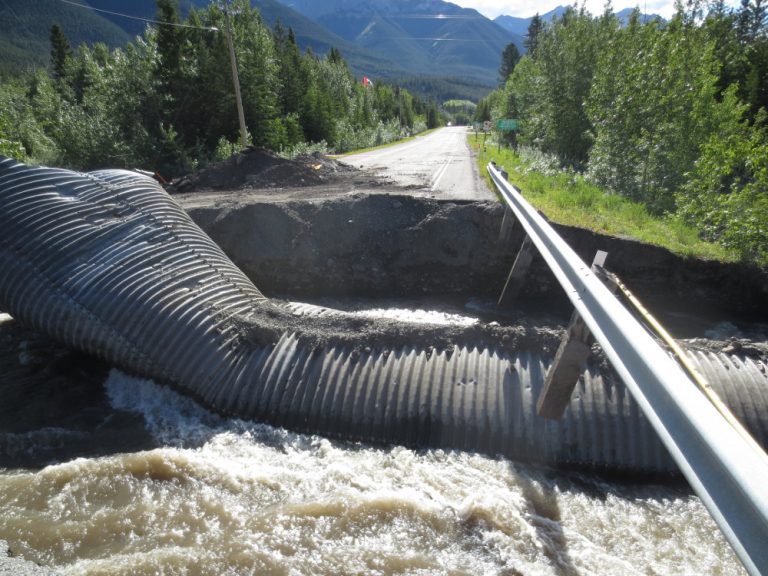When an extreme weather event meeting specific criteria occurs, the Government of Alberta has a system for providing direct financial assistance to those impacted.
Much like personal insurance, this system works by spreading risk and financial burden over many individuals – in this case all residents of Alberta.
The system is administered by the Alberta Emergency Management Agency (AEMA), under the Alberta Disaster Recovery Regulation and in alignment with the Alberta Disaster Assistance Guidelines [1]. It works by setting up individual Disaster Relief Programs (DRPs) for each extreme weather event that qualifies, following careful review by the AEMA and in co-operation with affected municipalities.
Funding from a DRP can be applied to financial recovery for “homes, farms and small businesses, municipal and provincial infrastructure, and [a municipality’s] emergency operations costs” [2].
Criteria to set up a DRP to assist recovery from an extreme weather event are:
The threshold for an extreme weather event to be considered extraordinary varies according to the nature of the event, although there are clear definitions for some types of events:
Damage related to other extreme weather events, such as hail and snow damage to vehicles and buildings, is unlikely to be covered by a DRP since personal insurance is widely available[6]. In some cases hail and snow can clog municipal drainage systems, either enabling or exacerbating urban flooding due to accompanying heavy rain. If a DRP is set up to deal with this event, it would likely be because of the damage caused by the flood waters, as opposed to any damage caused by hail/snow impacts to buildings and vehicles.
A DRP could also be set up specifically to assist a municipality with emergency operations and/or infrastructure repairs, even if funding does not go towards repairing any damages experienced by homeowners. For example, in a hail/snow storm, a DRP could be established if the storm necessitates a significant response from the municipality’s emergency response unit, but would not likely cover personal property damage related to hail and snow, due to the availability of personal insurance.
Similarly, it is unlikely that a DRP would be established to provide funds to farmers during a drought, since agricultural insurance is widely available [link to personal insurance]. However, there is another mechanism by which the Government of Alberta may provide financial assistance to farmers when drought takes its toll. By declaring a drought a disaster, the Government of Alberta enables the Agriculture Financial Services Corporation to access more funds for insurance compensation. For example, the 2015 drought was declared a disaster in Alberta, which enabled more insurance payouts to farmers by the Agriculture Financial Services Corporation, but a DRP was not established by the government of Alberta [7].
The Government of Alberta provides online information regarding individual DRPs once they are established. This can include information for individuals, farmers, and organizations to access funding.
Examples of DRPs are the 2005 and 2013 flooding in Calgary and Southern Alberta as well as the 2016 rainstorm in Lloydminster [8]. An example of an extreme weather event for which a DRP was not established is the 2014 Snowtember event in Calgary, which the AEMA determined did not qualify as an extreme weather event [9].

Once a DRP has been established for an extreme weather event, the relevant municipality/s will work with the AEMA to distribute funding to eligible parties. These activities can include organizing locations for public information, consultations, and notifying citizens how they can apply for funding.
The eligibility of “principal homeowners, tenants, small business owners, agricultural operators, condominium corporations, public institutions and not-for-profit organizations” to apply for DRP funding is determined by the AEMA on a case-by-case basis:
The Alberta Disaster Assistance Guidelines provide greater detail regarding the DRP approval process and eligibility for both the private and public sectors.
In the case of future flood events, the advent of flooding insurance in Alberta may have implications for DRP eligibility since one of the requisites for DRP eligibility is that insurance is not reasonably available, as determined by the AEMA [14].
It is critical homeowners review their flooding insurance options and consult available resources to understand how best to financially safeguard themselves against future floods. Although no specific guidelines have been released by the Government of Alberta regarding flood insurance, the Government does encourage homeowners to “obtain adequate coverage for their property” [15].
Share this Post:
We provide Canadian educational resources on water practices to promote conservation and sustainability. Our team crafts current and relevant content, while encouraging feedback and engagement.
The Canada WaterPortal is a registered charity, #807121876RR0001
We recognize and respect the sovereignty of the Indigenous Peoples and communities on whose land our work takes place.
© 2025 All Rights Reserved.